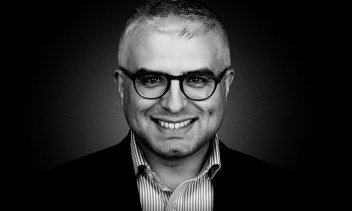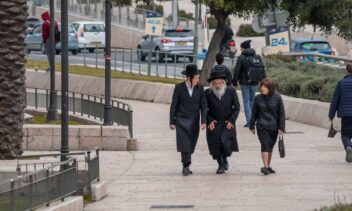This essay is the first in the author’s four-part series for 18Forty’s exploration of prayer and humanity. The entire series can be found compiled here.
“Prayer,” says Rabbi Jonathan Sacks in his introduction to the prayer book, “is the language of the soul in conversation with God. It is the most intimate gesture of the religious life, and the most transformative.”
From the very beginning, the created sought dialogue with the Creator. It was in the days of Enosh, son of Adam, that people “began to call in the Name of God” (Bereishit 4:26). One early recorded prayer is Moshe’s heartfelt appeal for his sister Miriam when she is afflicted with the skin disease tzara’at, “kel na refa na lah”—“O God please heal her!” (Bamidbar 12:13). The Psalms beseech God with the full range of human emotion and often seem spontaneous, composed in moments of pathos or jubilation.
Yet, over time, prayer, or tefilla, became fixed. Today, we pray from the siddur (lit. “order”), a book containing standardized texts for every day, every holiday, and every religious occasion.
Who wrote the siddur? Dr. Philip Birnbaum, the 20th-century scholar whose translation of the siddur was relied upon by English-speaking Jews for decades, suggests the beginnings of an answer:
If any single volume can tell us what it means to be a Jew, it is the Siddur which embodies the visions and aspirations, the sorrows and joys of many generations. The whole gamut of Jewish history may be traversed in its pages; it is a mirror that reflects the development of the Jewish spirit throughout the ages. … The Siddur passed through a long process of evolution until it finally emerged as a rich anthology of our literary classics. … The diversified authorship of the Siddur, embracing prophets and psalmists, legalists and poets, proclaims that all Israel has a share in its making.
In some sense, we are all the siddur’s authors. Still, one wonders, how exactly did this collection of prayers come to be?
I’ve searched high and low for an accessible English book or essay addressing the development of the siddur, but I’ve found only a few resources (see the further reading section below). This series of essays is my attempt to fill the gap. The history of the siddur’s composition is an entire field of scholarship, so to be sure, I’ll leave a lot out, and there is much I do not know. But I hope that this four-part introduction inspires further exploration.
We’ll begin (1), in this article, with the origins of fixed prayer; (2) then explore the disparate traditions of the Jewish communities in the Land of Israel and Geonic Babylonia; (3) turn to how the siddur grew throughout the medieval and early modern period, influenced by a host of spiritual and intellectual movements; and (4) conclude by discussing how all Jewish groups in the modern age—from Orthodox to Reform—grappled with how to respect the siddur while acknowledging contemporary realities. Throughout the series, we’ll keep in mind that, as Dr. Birnbaum wrote, the siddur has much to teach us about Jewish history and what it means to be a Jew.
Prayer in Tanach: Inspiration for the Structure
Prayer in Tanach is highly individual and inspired by the moment. Avraham interceded for the wicked people of Sodom (Bereishit 18:23). He prayed for Avimelech’s household to be healed after Avimelech wrongly took Sarah (20:17). God heard the cries of Hagar and Yishmael (21:16-17). These prayers (and others) seem situational, not structured and regular. And while it is true the Gemara quotes a baraita maintaining that the Patriarchs ordained the three daily prayers (Berachot 26b), the textual evidence for this is slim, and the Gemara does not suggest that the Patriarchs established the content or wording of any particular prayers.
Yet, later in Tanach, one can see glimmers of the structure and wording of our tefilla today. Jeremiah, Daniel, and Nehemiah, who lived toward the end of the biblical era, utilize a similar framework in their prayers. They each open by proclaiming God’s greatness, speak of God’s historical kindnesses to the Jewish People, such as redeeming them from Egypt, lament the people’s sinning, and plead for salvation (Jeremiah 32, Daniel 9, Nehemiah 1, 9).
The siddur we have today is structured around the same move from praise to petition. We begin the Amidah, or Shemoneh Esrei, by praising God before making requests. Of note, all of these prayers in Tanach (Jeremiah 32:18, Daniel 9:4, Nehemiah 1:5, 9:32) praise God using variations of the formula that begins Shemoneh Esrei, ha-kel ha-gadol ha-gibbor ve-hanora—“the Great, Mighty, and Awesome God,” which itself comes from Moshe’s description of God in Devarim (10:17). Finally, it’s worth pointing out that Daniel prayed three times a day facing Jerusalem (Daniel 6:11).
The Role of the Anshei Knesset Ha-Gedolah: Composition, or Something
Although we see no evidence in Tanach of a standard prayer service, Chazal, the Jewish Sages, attribute the origins of the siddur to the early Second Temple period (516-332 BCE) and a group of 120 people known as the Anshei Knesset Ha-Gedolah—the Men of the Great Assembly. Who exactly these people were, and what they did, is shrouded in mystery. Still, their ranks seem to have included Ezra and Nehemiah, as well as the prophets Haggai, Zechariah, and Malachi. According to Berachot 33a:
אָמַר רַבִּי חִיָּיא בַּר אַבָּא אָמַר רַבִּי יוֹחָנָן: אַנְשֵׁי כְּנֶסֶת הַגְּדוֹלָה תִּקְּנוּ לָהֶם לְיִשְׂרָאֵל בְּרָכוֹת וּתְפִלּוֹת, קְדוּשּׁוֹת וְהַבְדָּלוֹת
Rabbi Chiyya bar Abba said that Rabbi Yochanan said: The members of the Great Assembly established for Israel blessings and prayers, sanctifications and havdalot.
The Gemara says that the Anshei Knesset Ha-Gedolah established blessings, but does not tell us what they were. Moreover, it’s still unclear whether they composed the precise wording of any tefillot.
Elsewhere (Megillah 17b-18a), the Gemara grapples with a contradiction concerning the role of the Anshei Knesset Ha-Gedolah in composing the Shemoneh Esrei, the central part of our tefilla:
תְּפִלָּה מְנָא לַן? דְּתַנְיָא: שִׁמְעוֹן הַפָּקוֹלִי הִסְדִּיר שְׁמוֹנֶה עֶשְׂרֵה בְּרָכוֹת לִפְנֵי רַבָּן גַּמְלִיאֵל עַל הַסֵּדֶר בְּיַבְנֶה. אָמַר רַבִּי יוֹחָנָן, וְאָמְרִי לַהּ בְּמַתְנִיתָא תָּנָא: מֵאָה וְעֶשְׂרִים זְקֵנִים, וּבָהֶם כַּמָּה נְבִיאִים, תִּיקְּנוּ שְׁמוֹנֶה עֶשְׂרֵה בְּרָכוֹת עַל הַסֵּדֶר. … וְכִי מֵאַחַר דְּמֵאָה וְעֶשְׂרִים זְקֵנִים וּמֵהֶם כַּמָּה נְבִיאִים תִּקְּנוּ תְּפִלָּה עַל הַסֵּדֶר, שִׁמְעוֹן הַפָּקוֹלִי מַאי הִסְדִּיר? שְׁכָחוּם, וְחָזַר וְסִדְּרוֹם.
Where does the tefilla [Shemoneh Esrei] come from? As it is taught in a baraita: Shimon HaPakuli arranged the Shemoneh Esrei before Rabban Gamliel in their fixed order in Yavne. Rabbi Yochanan said, and some say that it was taught in a baraita: 120 Elders [i.e., the Men of the Great Assembly] and among them several prophets, established the Shemoneh Esrei in their fixed order. … Now, since 120 Elders, including many prophets, established the Amidah in its fixed order, what did Shimon HaPakuli arrange? They were forgotten, and he reestablished their order.
Rabban Gamliel, who led the Sages at Yavneh after the fall of the Second Temple in 70 CE, lived hundreds of years after the Anshei Knesset Ha–Gedolah. Thus, the Gemara suggests that even if the order of the Shemoneh Esrei was fixed in the early Second Temple period, it was forgotten and only reestablished centuries later. And it is again hard to know how much of the composition of the Shemoneh Esrei the Gemara attributes to the Anshei Knesset Ha–Gedolah. It sounds like perhaps they only established the order of the blessings, but did not fix their precise wording.
Prayer in the Mishna and Talmud: Pre-Siddur Prayer
Although the role of the Anshei Knesset Ha–Gedolah remains unclear, some of the daily prayers were in place before the destruction of the Second Temple and the cessation of the sacrificial order.
The Mishna (Tamid 5:1) states that when the priests brought the daily sacrifice:
אָמַר לָהֶם הַמְמֻנֶּה, בָּרְכוּ בְרָכָה אֶחַת, וְהֵן בֵּרְכוּ. קָרְאוּ עֲשֶׂרֶת הַדְּבָרִים, שְׁמַע, וְהָיָה אִם שָׁמֹעַ, וַיֹּאמֶר. בֵּרְכוּ אֶת הָעָם שָׁלשׁ בְּרָכוֹת, אֱמֶת וְיַצִּיב, וַעֲבוֹדָה, וּבִרְכַּת כֹּהֲנִים
The appointed priest said [to the other priests]: “Make one blessing [before Shema],” and they blessed. “Read the Ten Commandments, [the first paragraph] of Shema, Ve-Haya Im Shamoa, and Va-Yomer.” They blessed the people with three blessings: Emet ve-Yatziv, the Avodah, and the Priestly Blessing.
The Ten Commandments are no longer a prominent part of our daily prayers (see Yerushalmi Berachot 9b, which states that their recitation was abolished once heretics said that the Ten Commandments alone were given at Sinai), but we see that the three paragraphs of Shema were part of the Temple liturgy, as well as some of the blessings before and after it.
More tefillot were concretized in the Mishnaic period (10-200 CE), perhaps following the Temple’s destruction. The Mishna (Berachot 1:4) states that, in the morning, two blessings are recited before Shema and one after, while in the evening, two are recited before and two more after. This remains the case in the siddur today. Similarly, in the course of discussing the liturgy for Rosh Hashanah, the Mishna (Rosh Hashanah 4:5) lays out the basic structure of Shemoneh Esrei, noting the first three berachot and the final three by name.
The Gemara (200-500 CE), provides additional details and specifics about prayer. For example, Berachot 11b-12a mentions portions of the wording of the blessings before and after Shema, including a debate over whether the second beracha before Shema should begin with the words “ahavah rabbah”—“great love”—or “ahavat olam”—“eternal love.” (Today, “ahavah rabbah” is used in shacharit in Nusach Ashkenaz while “ahavat olam” is used during maariv in Ashkenaz and universally in Sephardic traditions.) Likewise, Megillah 17b-18a discusses the logic behind the order of each of the berachot in Shemoneh Esrei. Finally, the words of many of the morning blessings, including the Torah blessings, Elokai Neshamah, and others, are codified in the Gemara (Berachot 11b, 60b; Menachot 43b).
Another important source is Masechet Sofrim, one of the minor tractates composed in the seventh or eighth century. Although its final form is post-Talmudic and it largely concerns the rules for Torah scrolls, it discusses more explicitly than the Gemara many practices that have come to define our tefilla, such as the recitation of Kedushah—both before Shema and during Shemoneh Esrei (16:12), and Kaddish, including its refrain of amen yehei shmei rabbah (10:7, 21:6). (See also Berachot 21b for mention of Kedushah and Berachot 57a and Shabbat 119b for amen yehei shmei rabbah.) Sofrim further suggests the identity of some of the Psalms that comprise the Pesukei de-Zimra recited before Shema (17:11). Finally, Masechet Sofrim establishes the blessings before and after reading the Torah and Haftarah, as well as other parts of the Torah service (see Chapters 13 and 14).
Still, it’s important to be clear on one point: there was no written siddur in the time of the Mishna and Gemara. Tefilla was largely oral—memorized and transmitted. A midrash (Vayikra Rabbah 23:4) recounts that one time Rabbi Elazar was asked to lead the congregation in reciting Shema and Shemoneh Esrei, but he declined because he didn’t know how. Apparently, there was no written text for him to use. Just as it was forbidden to write down the Oral Torah, it would seem that one was not supposed to put blessings in writing either. The Gemara (Shabbat 115b) quotes a baraita stating that one may not save scrolls containing blessings from a fire on Shabbat even though they contain God’s Name. Because these scrolls are not to be saved from a conflagration, the Sages cautioned that “those who write blessings are like those who burn the Torah.”
The fact that prayer was oral meant that even when specific prayers were fixed, there was a great deal of variation in wording between communities and individuals. These variations are particularly significant for our next installment, where we will examine the distinct prayer traditions of the Jewish community in the Land of Israel in Talmudic and early medieval times, and how the community’s practices were criticized by the Geonim in Babylonia and others.
Yosef Lindell is a practicing lawyer and the Managing Editor of the Lehrhaus. He has a JD from NYU Law and an MA in Jewish history from Yeshiva University. Yosef’s writing spans several genres, from science fiction to scholarship, and he’s published more than 30 articles on Jewish history and thought. He lives in Silver Spring, MD, with his wife and two sons. His website is yoseflindell.wordpress.com.
Recommended Reading:
The history of Jewish liturgy and the development of the siddur is a vast field of study. Here are a few books and articles in English that can help the interested reader get started.
“The Endless Dimensions of the Siddur” by Rabbi Aharon Lopiansky (originally published in the journal Dialogue in 2013)
This article, by the Rosh Yeshiva of the Yeshiva of Greater Washington in Silver Spring, Maryland, where I live, is probably the most succinct and understandable introduction to the history of the siddur geared toward the Orthodox Jew.
Jewish Liturgy: A Comprehensive History by Ismar Elbogen (translated by Raymond P. Scheindlin)
This book is the granddaddy of siddur studies, and arguably still the most comprehensive, tracing the development of each of the tefillot. Elbogen, a renowned historian of Jewish liturgy, published the work in German in 1913 before fleeing Nazi Germany for the United States, but it’s been updated more than once, most recently in 1993 in English in the linked edition.
Judaism and Hebrew Prayer: New Perspectives on Jewish Liturgical History by Stefan C. Reif
Taking a different tack than Elbogen, Reif, the director of Genizah research at Cambridge University, does not provide details about particular prayers in this 1993 book, but instead aims to synthesize—to varying degrees of success—modern scholarship on the siddur into a narrative telling the story of Jewish prayer from biblical times to the 20th century.
Meditations on the Siddur by B.S. Jacobson (Rabbi Yissachar Yaakovson) (translated by Leonard Oschry)
This book is a 1966 translation of the introductory chapters of the 5-volume Hebrew commentary on the siddur Netiv Binah by Rav Yissachar Yaakovson, a 20th century educator who resided in Tel Aviv. The final chapter provides a short and engaging history of the development of the siddur with a wealth of examples based on Elbogen and other scholars.
Jewish Liturgy and its Development by A.Z. Idelsohn
Another oldie, this history of the siddur by the prominent ethnomusicologist Abraham Idelsohn, was first published in 1932. It covers some of the same ground as Elbogen, but is shorter and a little easier to read.
Newsletters of the Beurei Hatefila Institute by Abraham Katz
In the early 2000s, Abe Katz wrote hundreds of newsletters on the development of the siddur. They have since been compiled at the link above, and despite being a bit tricky to navigate, they are a treasure trove of information on the history of the prayers.








